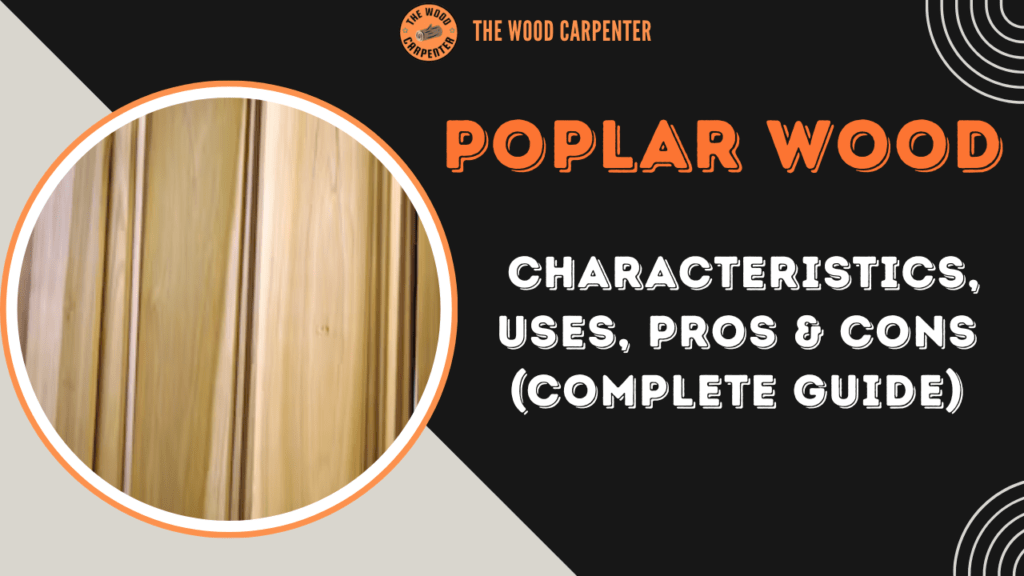
Poplar is popular because of its low cost and versatile, and environmentally friendly. It may not have the name recognition like oak or walnut, but this unassuming hardwood is used in furniture, cabinetry and all sorts of interior applications. In this complete guide, I’ll explain everything you need to know about poplar wood from what the pros and cons of using it & when is the best time to use it on a project.
What Is Poplar Wood?
Contrary to its name, the majority of poplar used in the United States is not actually derived from the populus genus, but rather from the tulip tree (Liriodendron tulipifera) – also known as yellow popular, tulipwood or whitewood. True poplars are in the genus Populus (which also includes cottonwood or aspen), but in woodworking the word “poplar” most often describes the American tulip tree.
Poplars grow very rapidly, and are of the most sustainable sources of hardwood available. They can be ready for harvest in as soon as 10 to 20 years versus slow-growing species such as oak or walnut.
Is Poplar a Hardwood or Softwood?
Poplar is actually a hardwood, as it is obtained from a broadleaf deciduous tree. But with a Janka hardness 540 lbf it is far softer than other woods such as:
Because of this, poplar is sometimes described as a “soft hardwood.” It machines and cuts more like a softwood, yet it carries the hardwood classification due to its botanical origin.
Poplar Wood characteristics
Appearance and Grain
Poplar wood has a subtle, understated look:
- Sapwood Color: Cream white to yellowish white
- Heartwood: Pale yellowish brown, with green, purple, or gray streaks.TrimSpace
- Grain: Even and uniform fine to medium texture straight
Exposure to sunlight means that a poplar wood’s characteristic greenish hues can darken into richer browns. Very uncommon “rainbow” poplar has streaks of yellow, purple, green, red, and black and is Beautiful!
Strength and Durability
Poplar is moderately strong, compared to other hardwoods, and not as durable as the denser woods. Key facts include:
- Light: Moderate weight (roughly 400 kg/m3 when dry.)
- With moderate strength: modulus of rupture about 9,200 lbf/in²
- Poor natural decay resistance: Vulnerable to moisture, decay and insects if not processed with preservatives
Due to its poor resistance to decay, poplar is generally not used outdoors without protection against decay, but it is rather easily preserved.
Workability
And one of poplar’s best assets is how easily it works:
- Works easily with hand and power tools
- Glues, nails, and screws well
- Sands to a smooth finish
- Accepts paint beautifully
Poplar takes stain but, due to its inconsistent grain and greenish streaks, the results may look blotchy. For the smoothest finish, use a wood conditioner before staining — or just use poplar instead for paint-grade projects.
Common Uses of Poplar Wood
Because of its affordability and versatility, poplar is often used in applications where function matters more than flashy appearance:
- Furniture frames – especially for upholstered furniture
- Cabinet interiors and drawer sides
- Decorative mouldings and trim
- Paint-grade furniture
- Plywood cores and veneers
- Crates, pallets, and utility items
Historically, Native Americans also carved tulip poplar into canoes, taking advantage of its light weight and ease of shaping.
Sustainability and Eco-Friendliness
Here’s why… Poplar is actually one of the most sustainable hardwoods:
- So-fast-growing: Reaches maturation in 10-20 years
- Common: Found throughout North America and Europe
- Green alternative: A renewable alternative to plastics and other less eco friendly materials
Because it regenerates quickly and harvest rates remain lower than growth rates, poplar is considered a responsible and eco-conscious choice.
Staining Poplar Wood
One common question is: does poplar stain well?
- Poplar tends to absorb stain unevenly because of its mixed grain density and greenish streaks.
- Without preparation, it can look blotchy.
- To improve results:
- Use a pre-stain wood conditioner
- Test on scrap pieces before staining
- Consider gel stains for better coverage
Many woodworkers prefer to paint poplar instead of staining it, but with the right preparation, it can take on darker finishes that mimic more expensive woods.
Poplar Wood Price
One of its biggest advantages is cost:
· Price per board foot: Typically $2 to $5, depending on grade and region
· Oak or walnut alternative: Much less expensive (usually less than half the price!)
· Why so affordable? Quick growing, poplar is also abundant and mills well
This affordability, in turn, makes poplar perfect for cost-conscious furniture making and larger projects.
Poplar Wood vs Pine
Poplar and pine are often compared because they are both inexpensive and widely used. Here’s how they differ:
| Feature | Poplar | Pine |
| Type | Hardwood | Softwood |
| Hardness (Janka) | 540 lbf | ~380–870 lbf (varies by species) |
| Appearance | Creamy with green/purple streaks | Pale yellow to reddish, with knots |
| Workability | Very smooth, machines well | Easy to cut but knots can make it harder |
| Staining | Can be blotchy, better for painting | Takes stain better, but soft grain absorbs unevenly |
| Best Use | Furniture frames, paint-grade projects, trim | Rustic furniture, construction, paneling |
👉 Key takeaway:
- Choose poplar if you want a smooth, uniform wood for painting or furniture interiors.
- Choose pine if you like natural knots and rustic character or plan to stain the wood.
Advantages of Poplar Wood
✔ Affordable compared to premium hardwoods
✔ Easy to machine, glue, and finish
✔ Lightweight yet stable
✔ Widely available in large boards and varied dimensions
✔ Eco-friendly and fast-growing
✔ Excellent paint-grade material
Disadvantages of Poplar Wood
✘ Softer and less durable than other hardwoods
✘ Not rot-resistant; unsuitable for outdoor use without treatment
✘ Can dent or scratch easily
✘ Staining may appear blotchy without preparation
✘ Less visually striking than woods like cherry, walnut, or oak
Is Poplar Wood Right for You?
Poplar is best suited for:
- Budget-friendly furniture
- Painted projects
- Interior trim and mouldings
- Drawer sides, cabinet interiors, and hidden structural parts
If you want a durable, heirloom-quality piece that highlights natural wood beauty, harder and more decorative woods like walnut, cherry, or oak may be better choices. But if you need an economical, versatile, and sustainable wood for interior use—especially where painting is planned—poplar is hard to beat.
Poplar Wood vs. Other Types of Wood
| Feature | Poplar Wood | Oak Wood | Pine Wood |
|---|---|---|---|
| Hardness | Medium | Hard | Soft |
| Price | Affordable | Expensive | Cheap |
| Workability | Easy | Moderate | Easy |
| Durability | Moderate | High | Low |
FAQs About Poplar Wood
1. Is poplar a good wood for furniture?
Yes—especially for painted furniture, frames, and interior applications. It is affordable, stable, and also easy to work with.
2. Why is poplar wood popular?
Because it is cheap, abundant, and versatile. It serves as a reliable “utility wood” in both furniture-making and in the construction.
3. Can poplar be used outdoors?
Not without proper sealing or preservative treatment, as it is not a naturally rot-resistant.
4. Is poplar eco-friendly?
Yes. Poplar grows quickly, regenerates easily, and contributes to the sustainable forestry.
5. Does poplar stain well?
It can, but staining may appear uneven without pre-conditioning. Poplar is often better painted.
Final Thoughts
Certainly poplar wood isn’t the hardest or most beautiful of hardwoods that exists, but its price, sustainability and simplicity make it popular in workshops everywhere. Whether you’re building cabinets, furniture frames, or creating a smooth finish for decorative moulding, poplar offers an inexpensive wood packed full of value in an easy-to-work with package that makes it one of the most commonly utilized hardwoods around.

